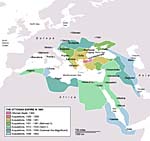
Unit 2: How Trade and Travel Changed the World
Lesson B: Life and Times in the Ottoman Empire
Lesson Overview
The rise and fall of religiously-based empires was a consistent theme of the pre-modern common era. Following the era of the Caliphates, Islamic states rose in regional locations of the Middle East, India, China, and Africa. The culture and commerce of these empires reflected Muslim traditions in combination with other religions and cultures of Afro-Eurasia. The Ottoman Empire reached its height during the 15th and 16th centuries, spreading its control over the Middle East, southeast Europe, and North Africa.
Key Questions
- How and why did trade and interaction lead to changes in political, economic, and social systems?
- How did geography and location significantly impact events in history?
- What factors contributed to the establishment, expansion, and decline of empires?
- How can there be different explanations of the same event in history?
Student Outcomes
- Summarize the scholarly, artistic, and architectural achievements of the Ottoman Empire.
- Analyze the role of trade and location in the origin, organization, and administration of the Ottoman Empire.
- Analyze the impact of the growth of the Ottoman Empire on the various peoples of the empire, including how Muslim, Orthodox Christians, Catholics, and Jewish peoples interacted under Ottoman rule.
- Identify the author or source of a historical document and explain the literal meaning of the document. (Historical Thinking Skill)
- Analyze change or continuity in areas of the world over time based on text and non-text information. (Historical Thinking Skill)
Key Terms
Student Resources
- The Rise of Islamic Empires Graphic Organizer (doc)
- Ottoman Women Historical Investigation (doc)
- Ottoman Melting Pot (doc)
- Ottoman Opportunity Brief Constructed Response (doc)
Chart of Activities:
| Activities to Complete | Estimated Time |
|---|---|
| Pre-Assessment | 10 minutes |
| Key Terms | 5 minutes |
| Activator: The World 1300-1550 | 5 minutes |
| Opening: Religion in Today's World | 10 minutes |
| Activity 1: Mohammed to the Ottomans | 20 minutes |
| Activity 2: Religious Conflicts of Yesterday and Today | 15 minutes |
| Activity 3: Women of the Ottoman World | 15 minutes |
| Activity 4: A Patchwork Ottoman World | 15 minutes |
| Activity 5: The Ottoman Opportunity | 10 minutes |
| Activity 6: The Ottoman Economy | 10 minutes |
| Activity 7: Trade under the Ottomans | 10 minutes |
| Review and Assessment | 15 minutes |
| Lesson Summary | 5 minutes |
Lesson Completion Time
The total estimated time to complete this lesson is 145 minutes.
Page Notes:
[1] Source: This image from http://en.wikipedia.org/wiki/File:OttomanEmpireIn1683.png is in the public domain.


